论如何当好科技翻译
翻译目的论视角下的科技英汉翻译实践报告
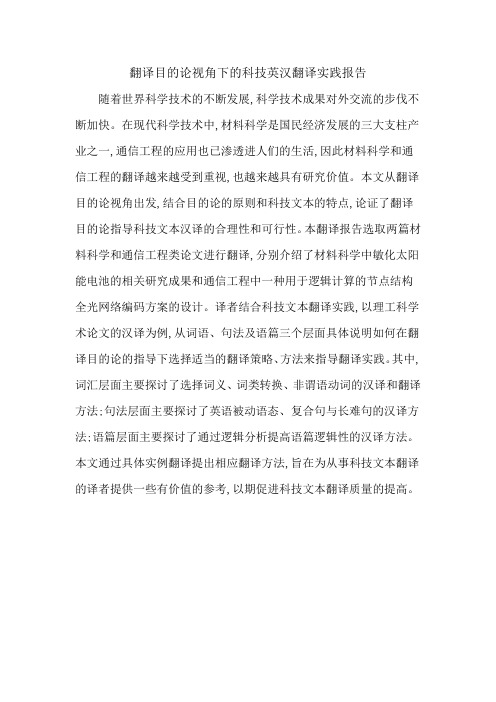
翻译目的论视角下的科技英汉翻译实践报告随着世界科学技术的不断发展,科学技术成果对外交流的步伐不断加快。
在现代科学技术中,材料科学是国民经济发展的三大支柱产业之一,通信工程的应用也已渗透进人们的生活,因此材料科学和通信工程的翻译越来越受到重视,也越来越具有研究价值。
本文从翻译目的论视角出发,结合目的论的原则和科技文本的特点,论证了翻译目的论指导科技文本汉译的合理性和可行性。
本翻译报告选取两篇材料科学和通信工程类论文进行翻译,分别介绍了材料科学中敏化太阳能电池的相关研究成果和通信工程中一种用于逻辑计算的节点结构全光网络编码方案的设计。
译者结合科技文本翻译实践,以理工科学术论文的汉译为例,从词语、句法及语篇三个层面具体说明如何在翻译目的论的指导下选择适当的翻译策略、方法来指导翻译实践。
其中,词汇层面主要探讨了选择词义、词类转换、非谓语动词的汉译和翻译方法;句法层面主要探讨了英语被动语态、复合句与长难句的汉译方法;语篇层面主要探讨了通过逻辑分析提高语篇逻辑性的汉译方法。
本文通过具体实例翻译提出相应翻译方法,旨在为从事科技文本翻译的译者提供一些有价值的参考,以期促进科技文本翻译质量的提高。
目的论视角下的科技英语翻译策略
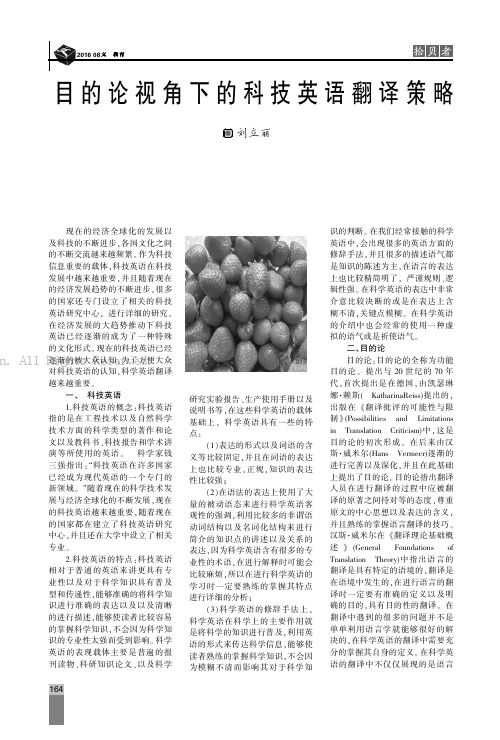
2016.08现在的经济全球化的发展以及科技的不断进步,各国文化之间的不断交流越来越频繁。
作为科技信息重要的载体,科技英语在科技发展中越来越重要,并且随着现在的经济发展趋势的不断进步,很多的国家还专门设立了相关的科技英语研究中心,进行详细的研究。
在经济发展的大趋势推动下科技英语已经逐渐的成为了一种特殊的文化形式。
现在的科技英语已经逐渐的被大众认知,为了方便大众对科技英语的认知,科学英语翻译越来越重要。
一、科技英语1.科技英语的概念:科技英语指的是在工程技术以及自然科学技术方面的科学类型的著作和论文以及教科书、科技报告和学术讲演等所使用的英语。
科学家钱三强指出:“科技英语在许多国家已经成为现代英语的一个专门的新领域。
”随着现在的科学技术发展与经济全球化的不断发展,现在的科技英语越来越重要,随着现在的国家都在建立了科技英语研究中心,并且还在大学中设立了相关专业。
2.科技英语的特点:科技英语相对于普通的英语来讲更具有专业性以及对于科学知识具有普及型和传递性,能够准确的将科学知识进行准确的表达以及以及清晰的进行描述,能够使读者比较容易的掌握科学知识,不会因为科学知识的专业性太强而受到影响。
科学英语的表现载体主要是普遍的报刊读物、科研知识论文、以及科学研究实验报告、生产使用手册以及说明书等,在这些科学英语的载体基础上,科学英语具有一些的特点:(1)表达的形式以及词语的含义等比较固定,并且在词语的表达上也比较专业,正规,知识的表达性比较强;(2)在语法的表达上使用了大量的被动语态来进行科学英语客观性的强调,利用比较多的非谓语动词结构以及名词化结构来进行简介的知识点的讲述以及关系的表达,因为科学英语含有很多的专业性的术语,在进行解释时可能会比较麻烦,所以在进行科学英语的学习时一定要熟练的掌握其特点进行详细的分析;(3)科学英语的修辞手法上,科学英语在科学上的主要作用就是将科学的知识进行普及,利用英语的形式来传达科学信息,能够使读者熟练的掌握科学知识,不会因为模糊不清而影响其对于科学知识的判断。
功能翻译理论指导下的科技翻译策略

法则” 简言之 , 就是译文在 目标语读者 中产生一定 的意义。“ 忠实法则” 是指译文尽可能 的忠实源文。 在 目的论中, “ 忠实法则” 具体是指译者对源文 的理 解和翻译 的目的不能偏离源文的期待。 二、 科技 英 语 的功能 分析 ( 一) 科技文本 的类型和功能 科技英语一般指在 自 然科学和工程技术方面的 科学著作 、 论文、 教科 书、 科 技报告和学术讲演 中所 使用的英语 , 其 目的是使读者或听众容易理解而不
赖斯根据文本的交际功能把文本分 为传意 、 表 情和使役三种类 型, 并分别予 以阐述。从字面意思 可判断 , 传意文本 旨在传达信息 , 真实和准确是传意 文本 的题中之意。表情文本是指保 留源文中具有美
学功能的信息 , 以便 向读 者传达一 定 的美 学效果。 因此 , 源文的形式就有 了保 留的必要。使役文本 旨
点 。所 以 , 弗米 尔给 出的 翻译 定 义 为 , 在 “目的语 情 景 中为 某种 目的及 目的受 众 而 生产 的语 篇 ” 。 目的 论包 括 三个 法则 , 即“目的法则 ” 、 “ 连 贯法 则 ” 和“ 忠
实法则” 。“ 目的法则” 要求译者按照源文 目的, 受
众 的要 求 , 抑 或是 委 托 人 的要 求 进 行 翻译 。“ 连 贯
类 型 及其 功能 , 以便更 好 地分 析文 本 , 为科 技英 语 翻 译 提供 导 向作用 。 ( 一) 文本功 能类的社会环境 , 他们 对译文的要求和期待都有所不同。因此 , 译文 目的 和译 文 受众 成 为功 能 翻 译理 论 、 更 是 目的论 的 出发
2 0 1 3年第 0 2期 第2 9卷 ( 总3 3 8期 )
吉 林 省教 育 学 院学 报
从目的论角度看科技文本翻译方法
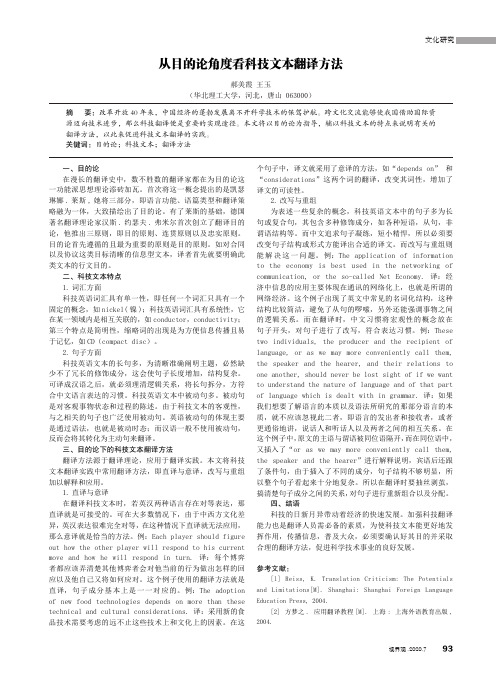
文化研究从目的论角度看科技文本翻译方法郝美霞 王玉(华北理工大学,河北,唐山 063000)摘 要:改革开放40年来,中国经济的蓬勃发展离不开科学技术的保驾护航。
跨文化交流能够使我国借助国际资源迈向技术进步,那么科技翻译便是重要的实现途径。
本文将以目的论为指导,辅以科技文本的特点来说明有关的翻译方法,以此来促进科技文本翻译的实践。
关键词:目的论;科技文本;翻译方法一、目的论在漫长的翻译史中,数不胜数的翻译家都在为目的论这一功能派思想理论添砖加瓦。
首次将这一概念提出的是凯瑟琳娜.莱斯,她将三部分,即语言功能、语篇类型和翻译策略融为一体,大致描绘出了目的论。
有了莱斯的基础,德国著名翻译理论家汉斯.约瑟夫.弗米尔首次创立了翻译目的论,他推出三原则,即目的原则、连贯原则以及忠实原则。
目的论首先遵循的且最为重要的原则是目的原则。
如对合同以及协议这类目标清晰的信息型文本,译者首先就要明确此类文本的行文目的。
二、科技文本特点1.词汇方面科技英语词汇具有单一性,即任何一个词汇只具有一个固定的概念,如nickel(镍);科技英语词汇具有系统性,它在某一领域内是相互关联的,如conductor,conductivity;第三个特点是简明性,缩略词的出现是为方便信息传播且易于记忆,如CD(compact disc)。
2.句子方面科技英语文本的长句多,为清晰准确阐明主题,必然缺少不了冗长的修饰成分,这会使句子长度增加,结构复杂。
可译成汉语之后,就必须理清逻辑关系,将长句拆分,方符合中文语言表达的习惯。
科技英语文本中被动句多。
被动句是对客观事物状态和过程的陈述。
由于科技文本的客观性,与之相关的句子也广泛使用被动句。
英语被动句的体现主要是通过语法,也就是被动时态;而汉语一般不使用被动句,反而会将其转化为主动句来翻译。
三、目的论下的科技文本翻译方法翻译方法源于翻译理论,应用于翻译实践。
本文将科技文本翻译实践中常用翻译方法,即直译与意译,改写与重组加以解释和应用。
试论科技英语的特征及翻译技巧
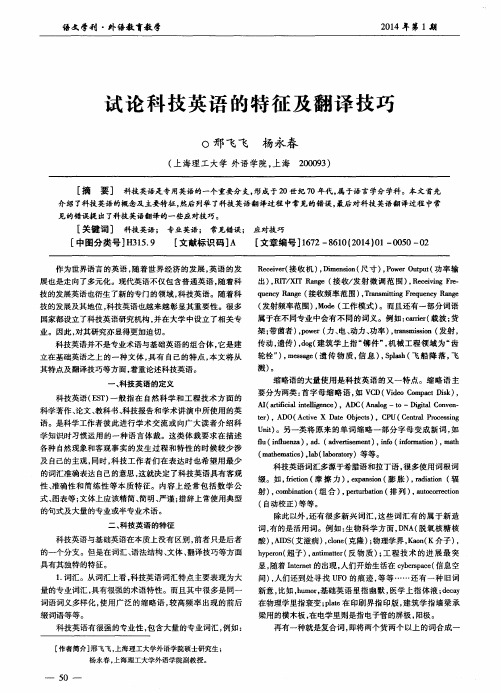
二、 科 技 英 语 的 特 征
( m a t h e ma t i c s ) , l a b ( 1 a b o r a t o r y )等等 。 科技英语词汇多源于希腊语和拉丁语 , 很多使用词根词
缀 。如 , f r i c i t o n( 摩擦力 ) , e x p a n s i o n( 膨 胀) , r a d i a t i o n( 辐 射) , c o m b i n a i t o n ( 组合) , p e r t u r b a i t o n( 排列) , a u t o e o r r ct e i o n ( 自动校正) 等等 。
其特点及翻译技 巧等方面 , 着重论述科技英语 。
一
、
科技 英语 的定 义
缩略语 的大量使 用是 科技英语 的又一 特点 。缩 略语 主
科技英语 ( E S T ) 一般 指在 自然科 学 和工程 技术 方面 的
科学著作 、 论文 、 教科书、 科技报告和学术讲 演中所使用 的英
语 。是科学工作者彼此 进行学术 交流 或 向广 大读 者介绍科 学知识时习惯运用 的一 种语言体 裁。这类体 裁要 求在描述 各种 自然现象和客观事 实的 发生过 程和特性 的时 候较少 涉
要 分为两类 : 首字母 缩略 语 , 如V C D( V i d e o C o m p a c t D i s k ) ,
A I ( a r t i i f c i a l i n t e l l i g e n e) c ,A D C( A n a l o g—t o—D i t t a l C o n v e n - t e r ) , A D O( A c t i v e X D a t e O b j e c t s ) ,C P U( C e n t r a l P r o c ss e i n g
论科技翻译中的美学体现
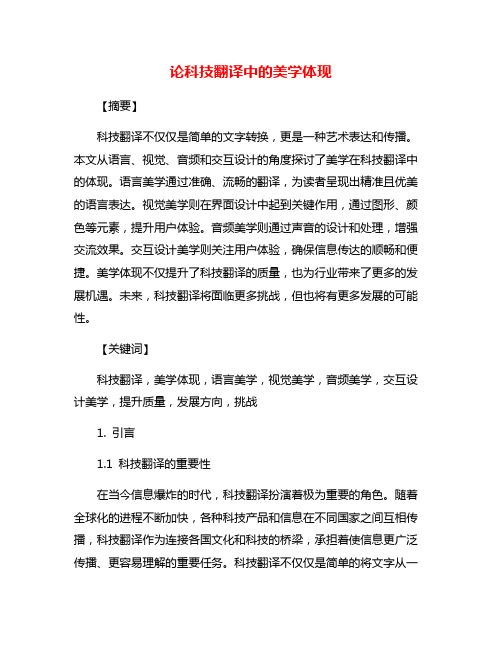
论科技翻译中的美学体现【摘要】科技翻译不仅仅是简单的文字转换,更是一种艺术表达和传播。
本文从语言、视觉、音频和交互设计的角度探讨了美学在科技翻译中的体现。
语言美学通过准确、流畅的翻译,为读者呈现出精准且优美的语言表达。
视觉美学则在界面设计中起到关键作用,通过图形、颜色等元素,提升用户体验。
音频美学则通过声音的设计和处理,增强交流效果。
交互设计美学则关注用户体验,确保信息传达的顺畅和便捷。
美学体现不仅提升了科技翻译的质量,也为行业带来了更多的发展机遇。
未来,科技翻译将面临更多挑战,但也将有更多发展的可能性。
【关键词】科技翻译,美学体现,语言美学,视觉美学,音频美学,交互设计美学,提升质量,发展方向,挑战1. 引言1.1 科技翻译的重要性在当今信息爆炸的时代,科技翻译扮演着极为重要的角色。
随着全球化的进程不断加快,各种科技产品和信息在不同国家之间互相传播,科技翻译作为连接各国文化和科技的桥梁,承担着使信息更广泛传播、更容易理解的重要任务。
科技翻译不仅仅是简单的将文字从一种语言翻译成另一种语言,更重要的是要准确传达原文背后的专业知识和科技含义,确保信息的准确性和权威性。
在当今科技高度发达的背景下,科技翻译的重要性愈发凸显。
从软件应用到新兴技术,从科研成果到工程设计,科技翻译贯穿于各个领域,并且对于推动科技创新和促进跨文化交流起着至关重要的作用。
只有通过科技翻译,不同国家的科学家、工程师和研究人员才能共同交流分享各自的成果和经验,实现科技进步的跨越。
科技翻译的重要性不仅仅体现在信息传播和沟通交流的层面上,更深层次的在于推动科技发展、促进跨文化融合,为全球科技合作和创新注入强大的动力。
在这个信息时代,科技翻译的作用愈发不可或缺,其重要性也日益凸显。
1.2 美学在科技翻译中的地位美学在科技翻译中的地位是至关重要的。
美学是一种人类审美情感的体现,通过美学的运用可以提升科技翻译的质量和效果。
在科技翻译中,美学不仅仅是为了让翻译作品看起来更加美观,更重要的是通过美学的层层嵌入,使得翻译作品更具有吸引力和影响力。
浅析翻译模因论指导下的科技翻译

浅析翻译模因论指导下的科技翻译随着科学技术的不断发展与进步,科技翻译的需求也越来越大。
但由于科技翻译所具有的一些的特点,如专业词汇多,句子结构复杂、长难句较多等,使得科技翻译存在一定的难度,也存在一些问题。
基于达尔文进化论的模因论在与翻译理论结合后形成的翻译模因论对科技翻译有一定的指导作用,通过大量储存模因,准确理解源语模因,选择最佳模因,能有效地减少科技翻译中存在的一些问题,并提升翻译质量。
标签:模因翻译模因论科技翻译自进入新世纪以来,科技发展愈加迅速,为了使各国间能相互交流科技发展的成果,推动科技进步,科技翻译尤为重要。
而科技翻译不同于其他文体的翻译,它专业词汇多,句式复杂等特点,这些特点加大了科技翻译的难度。
致使某些科技翻译或多或少都存在一些问题,直接影响了科技的传播与发展,因此这些问题都亟待解决。
在达尔文进化理论基础上衍生出来的解释语言传播规律的语言模因论在与翻译理论相结合后形成了翻译模因论,该理论能有效地指导科技翻译,改善现在科技翻译中存在的一些欠缺。
一、翻译模因论据《牛津英语词典》解释:模因是文化的基本单位,通过非遗传的方式,特别是模仿而得到传递。
作为文化传播单位,模因的存在形式多种多样,一切能被模仿复制,并得以传播的事物都能被称为模因,如:绘画手法,建筑风格,衣服样式,诗歌形式等等。
在语言上,也存在模因,如一些习语,谚语。
或者,在更广义的范畴中,语言本身就是模因,这体现在字、词、句、乃至篇章层面上。
[1](P55)语言作为文化交流的载体,自然需要翻译,语言模因也同样如此。
安德鲁·切斯特曼(Andrew Chesteman)和汉斯·弗米尔(Hans J Vermeer)最早将模因与翻译理论研究相结合,提出了翻译模因论。
切斯特曼把有关翻译的概念,观点,目的,策略和价值观念等与模因论结合起来,形成了一个系统的模因论。
他的翻译模因论的核心理念是规范模因,策略模因和价值模因,三者互为联系,翻译是模因的生存机器。
变译理论在科技英语翻译中的应用探索
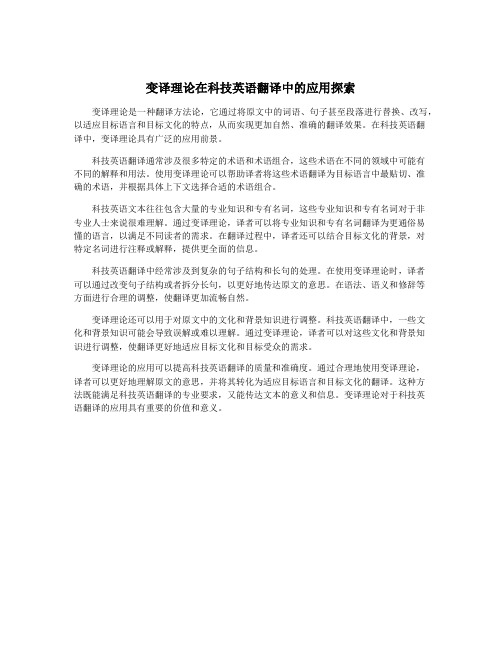
变译理论在科技英语翻译中的应用探索变译理论是一种翻译方法论,它通过将原文中的词语、句子甚至段落进行替换、改写,以适应目标语言和目标文化的特点,从而实现更加自然、准确的翻译效果。
在科技英语翻译中,变译理论具有广泛的应用前景。
科技英语翻译通常涉及很多特定的术语和术语组合,这些术语在不同的领域中可能有不同的解释和用法。
使用变译理论可以帮助译者将这些术语翻译为目标语言中最贴切、准确的术语,并根据具体上下文选择合适的术语组合。
科技英语文本往往包含大量的专业知识和专有名词,这些专业知识和专有名词对于非专业人士来说很难理解。
通过变译理论,译者可以将专业知识和专有名词翻译为更通俗易懂的语言,以满足不同读者的需求。
在翻译过程中,译者还可以结合目标文化的背景,对特定名词进行注释或解释,提供更全面的信息。
科技英语翻译中经常涉及到复杂的句子结构和长句的处理。
在使用变译理论时,译者可以通过改变句子结构或者拆分长句,以更好地传达原文的意思。
在语法、语义和修辞等方面进行合理的调整,使翻译更加流畅自然。
变译理论还可以用于对原文中的文化和背景知识进行调整。
科技英语翻译中,一些文化和背景知识可能会导致误解或难以理解。
通过变译理论,译者可以对这些文化和背景知识进行调整,使翻译更好地适应目标文化和目标受众的需求。
变译理论的应用可以提高科技英语翻译的质量和准确度。
通过合理地使用变译理论,译者可以更好地理解原文的意思,并将其转化为适应目标语言和目标文化的翻译。
这种方法既能满足科技英语翻译的专业要求,又能传达文本的意义和信息。
变译理论对于科技英语翻译的应用具有重要的价值和意义。
浅析翻译目的论在翻译实践中的应用
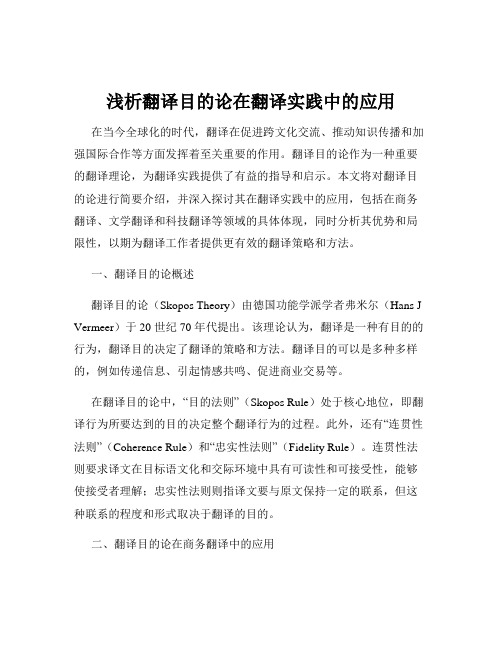
浅析翻译目的论在翻译实践中的应用在当今全球化的时代,翻译在促进跨文化交流、推动知识传播和加强国际合作等方面发挥着至关重要的作用。
翻译目的论作为一种重要的翻译理论,为翻译实践提供了有益的指导和启示。
本文将对翻译目的论进行简要介绍,并深入探讨其在翻译实践中的应用,包括在商务翻译、文学翻译和科技翻译等领域的具体体现,同时分析其优势和局限性,以期为翻译工作者提供更有效的翻译策略和方法。
一、翻译目的论概述翻译目的论(Skopos Theory)由德国功能学派学者弗米尔(Hans J Vermeer)于 20 世纪 70 年代提出。
该理论认为,翻译是一种有目的的行为,翻译目的决定了翻译的策略和方法。
翻译目的可以是多种多样的,例如传递信息、引起情感共鸣、促进商业交易等。
在翻译目的论中,“目的法则”(Skopos Rule)处于核心地位,即翻译行为所要达到的目的决定整个翻译行为的过程。
此外,还有“连贯性法则”(Coherence Rule)和“忠实性法则”(Fidelity Rule)。
连贯性法则要求译文在目标语文化和交际环境中具有可读性和可接受性,能够使接受者理解;忠实性法则则指译文要与原文保持一定的联系,但这种联系的程度和形式取决于翻译的目的。
二、翻译目的论在商务翻译中的应用商务翻译涉及合同、商务信函、产品说明书等多种文本类型,其目的通常是为了促进商务活动的顺利进行和达成交易。
在商务翻译中,翻译目的论的应用主要体现在以下几个方面:1、术语的准确翻译商务领域有大量的专业术语,准确翻译这些术语对于传达准确的商务信息至关重要。
翻译目的决定了术语翻译的方法。
例如,如果翻译的目的是为了让目标读者快速理解文本的主要内容,对于一些复杂的术语可以采用意译的方法,用通俗易懂的语言进行解释;如果是为了保持法律文件的严谨性和权威性,则可能需要采用直译或音译加注释的方法,以确保术语的准确性和专业性。
2、文化适应不同国家和地区在商务文化方面存在差异。
论科技英语的持点和翻译对策
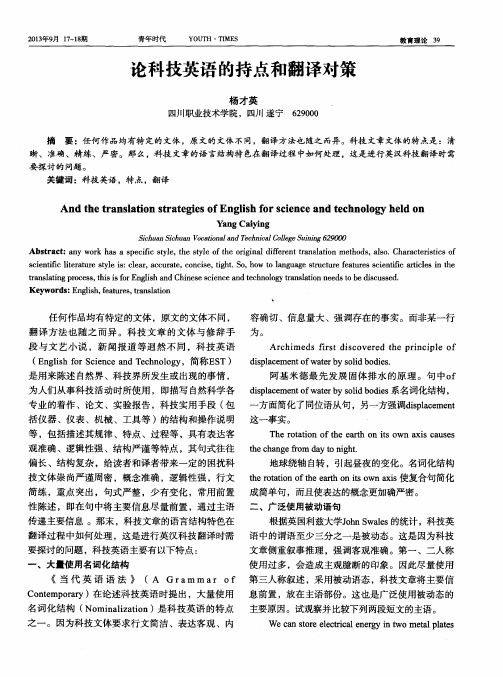
晰、准确、精练、严密。那么, 科技文章的语言结构特 色 在翻译过程中如何处理 ,这是进行英汉科技翻译时需
要 探 讨 的 问题 。
关键词 :科技 英语 ,特点 ,翻译
And t h e t r a ns l a t i o n s t r a t e g i e s o f En g l i s h f o r s c i e n c e a nd t e c h n o l o g y h e l d o n
容确切 、信息量大、强调存在的事实。而非某一行
Ar c h i me d s f i r s t d i s c o v e r e d t h e p r i n c i p l e o f d i s p l a c e me n t o f wa t e r b y s o l i d b o d i e s .
Ke y wo r d s : E n l g i s h , f e a t u r e s , t r a n s l a t i o n
任何作 品均有特定的文体 ,原文的文体不 同,
段与文 艺小说 ,新 闻报 道等迥然 不 同 ,科 技英语
( E n g l i s h f o r S c i e n c e a n d T e c h n o l o g y ,简 称 E S T)s , t h i s i s f o r En g l i s h a n d Ch i n e s e s c i e n c e a n d t e c h n o l o g y t r a n s l a t i o n n e e d s t o b e d i s c us s e d .
阿基 米德最先 发展 固体排 水 的原理 。句 中0 f 方面简化了同位语从句 ,另一方强调d i s p l a c e me n t
论科技翻译中的_形似_与_神似_

2008年第24卷第2期中北大学学报(社会科学版)V ol.24 N o.2 2008 (总第98期)JO URNAL OF NORTH UNIVERSITY OF CH INA(SO CI AL SCIENCE EDITION)(Sum.98)文章编号:1673-1646(2008)02-0038-03论科技翻译中的“形似”与“神似”薛宁地(顺德职业技术学院外语系,广东佛山528333) 摘 要: 文学翻译中所讨论的“形似”与“神似”的问题在科技翻译中也存在。
科技翻译应分两部分来考虑翻译原则:一部分是除核心词语以外的部分,这里基本不用考虑“形似”与“神似”的问题,译文只求“准确,易懂”。
另一部分是核心词语的翻译,即新出现的科技词语的翻译。
翻译核心词语的时候,译者应该尽量争取做到译文与原文不仅“形似”,而且“神似”。
关键词: 科技翻译;形似;神似;核心词语 中图分类号: H315.9 文献标识码: AOn Appearance R esemblance an d Spiritu al Resemblancein Scientific and Tech nical Tran slationXUE Ningdi(Dept.o f Fo reig n L ang uage,Shunde Po ly technic,Fo sha n528333,China)Abstract:The issue of appear ance resemblance and spiritual resemblance that has been discussed in literary translation also ex ists in scientific and technical translation.Scientific and technical tr anslation should be divided into tw o parts for consideration of translation pr inciples.T he first part is all the text except the co re terms.Here ther e is basically no need to consider the issue o f appearance resemblance and spir itual resem blance ;the objective is to achieve both accuracy and plainness .T he other part is the co re terms,nam ely,new ly g enerated scientific and technical term s.When such core ter ms are translated,the translator s o bjective should achieve both appearance resemblance and spiritual resemblance .Key words:scientific and technical translation;appearance resemblance;spir itual resemblance;core ter ms1 “形似”与“神似”概念的提出20世纪50年代初,我国著名翻译家傅雷提出了一个后来被证明有深远影响的关于翻译理论和实践的观点。
论如何避免科技英语翻译中的洋腔洋调
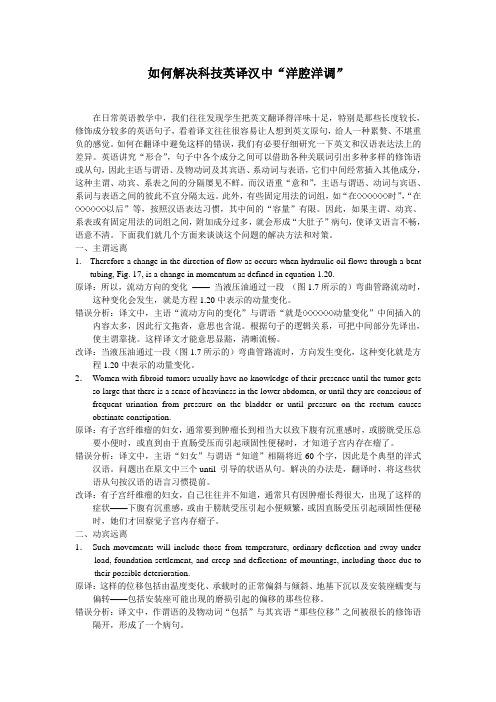
如何解决科技英译汉中“洋腔洋调”在日常英语教学中,我们往往发现学生把英文翻译得洋味十足,特别是那些长度较长,修饰成分较多的英语句子,看着译文往往很容易让人想到英文原句,给人一种累赘、不堪重负的感觉。
如何在翻译中避免这样的错误,我们有必要仔细研究一下英文和汉语表达法上的差异。
英语讲究“形合”,句子中各个成分之间可以借助各种关联词引出多种多样的修饰语或从句,因此主语与谓语、及物动词及其宾语、系动词与表语,它们中间经常插入其他成分,这种主谓、动宾、系表之间的分隔屡见不鲜。
而汉语重“意和”,主语与谓语、动词与宾语、系词与表语之间的彼此不宜分隔太远。
此外,有些固定用法的词组,如“在ּּּּּּ时”,“在ּּּּּּ以后”等,按照汉语表达习惯,其中间的“容量”有限。
因此,如果主谓、动宾、系表或有固定用法的词组之间,附加成分过多,就会形成“大肚子”病句,使译文语言不畅,语意不清。
下面我们就几个方面来谈谈这个问题的解决方法和对策。
一、主谓远离1.Therefore a change in the direction of flow as occurs when hydraulic oil flows through a benttubing, Fig. 17, is a change in momentum as defined in equation 1.20.原译:所以,流动方向的变化——当液压油通过一段(图1.7所示的)弯曲管路流动时,这种变化会发生,就是方程1.20中表示的动量变化。
错误分析:译文中,主语“流动方向的变化”与谓语“就是ּּּּּּ动量变化”中间插入的内容太多,因此行文拖沓,意思也含混。
根据句子的逻辑关系,可把中间部分先译出,使主谓靠拢。
这样译文才能意思显豁,清晰流畅。
改译:当液压油通过一段(图1.7所示的)弯曲管路流时,方向发生变化,这种变化就是方程1.20中表示的动量变化。
2.Women with fibroid tumors usually have no knowledge of their presence until the tumor gets so large that there is a sense of heaviness in the lower abdomen, or until they are conscious of frequent urination from pressure on the bladder or until pressure on the rectum causes obstinate constipation.原译:有子宫纤维瘤的妇女,通常要到肿瘤长到相当大以致下腹有沉重感时,或膀胱受压总要小便时,或直到由于直肠受压而引起顽固性便秘时,才知道子宫内存在瘤了。
功能翻译理论在科技翻译中的应用
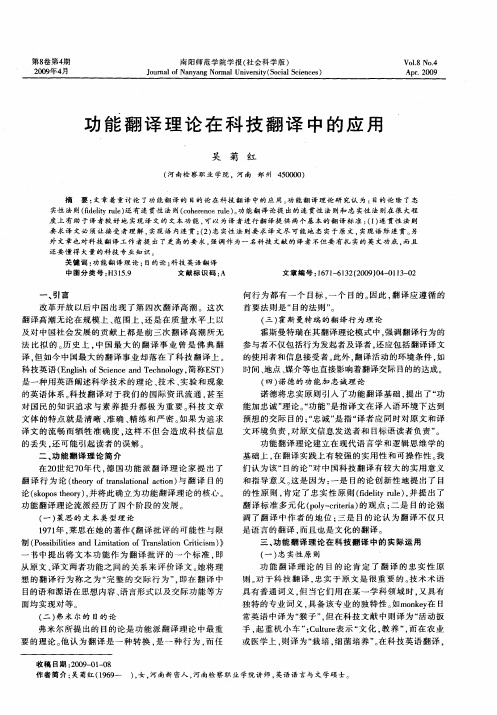
实性 法 则 ( d lyr l) 有 连 贯 性 法 则 ( o ee c l ) 功 能 翻 译 论提 出的连 贯性 法 则 和 忠 实性 法 则 在 很 大程 i i f e t ue 还 c h rn er e 。 u
度 上 有 助 于译 者 较 好 地 实现 译 文 的 文 本 功 能 , 以 为 译 者 进 行 翻 译 提 供 两个 基 本 的翻 译 标 准 : 1连 贯 性 法 则 可 ()
功 能 翻 译 理 论 在 科 技 翻 译 中 的 应 用
吴 菊 红
( 南检 察 职 业 学 院 ,河 南 郑 州 4 0 0 ) 河 5 0 0
摘
要: 文章 着 重 讨 论 了功 能 翻 译 的 目的论 在 科 技 翻 译 中的 应 用 。 能 翻 译 理 论 研 究认 为 : 功 目的 论 除 了 忠
是 语 言 的 翻译 , 且也 是 文 化 的 翻译 。 而 三 、 能翻 译 理论 在 科 技翻 译 中 的 实 际 运 用 功
一
、
引言
何 行 为 都 有 一 个 目标 , 个 目的 。 一 因此 , 译 应 遵 循 的 翻
首要法则是 “ 目的 法 则 ” 。
改 革 开 放 以后 中 国 出现 了第 四 次 翻 译 高 潮 。这 次 翻 译 高 潮 无 论 在 规 模 上 、 围上 , 是 在 质 量 水 平 上 以 范 还 及对中国社会发展的贡献上都是前 三次翻译高潮所无 法 比 拟 的 。 史 上 , 国 最 大 的 翻 译 事 业 曾 是 佛 典 翻 历 中 译 , 如 今 中 国 最 大 的 翻 译 事 业 却 落 在 了 科 技 翻译 上 。 但 科 技 英 语 ( nlho c neadT cnlg , 称E T E g s f i c n eh o y 简 i Se o S) 是 一 种 用 英 语 阐 述 科 学 技 术 的理 论 、 术 、 验 和 现 象 技 实 的 英 语体 系 。 技 翻 译 对 于 我 们 的 国 际 资 讯 流 通 , 至 科 甚 对 国民的知识追求 与素养 提升都 极为重 要 。 技文章 科
翻译目的论指导下的科技文本翻译
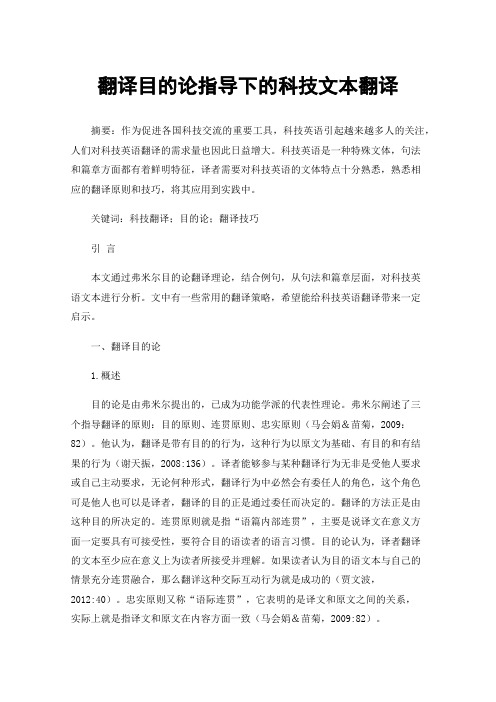
翻译目的论指导下的科技文本翻译摘要:作为促进各国科技交流的重要工具,科技英语引起越来越多人的关注,人们对科技英语翻译的需求量也因此日益增大。
科技英语是一种特殊文体,句法和篇章方面都有着鲜明特征,译者需要对科技英语的文体特点十分熟悉,熟悉相应的翻译原则和技巧,将其应用到实践中。
关键词:科技翻译;目的论;翻译技巧引言本文通过弗米尔目的论翻译理论,结合例句,从句法和篇章层面,对科技英语文本进行分析。
文中有一些常用的翻译策略,希望能给科技英语翻译带来一定启示。
一、翻译目的论1.概述目的论是由弗米尔提出的,已成为功能学派的代表性理论。
弗米尔阐述了三个指导翻译的原则:目的原则、连贯原则、忠实原则(马会娟&苗菊,2009:82)。
他认为,翻译是带有目的的行为,这种行为以原文为基础、有目的和有结果的行为(谢天振,2008:136)。
译者能够参与某种翻译行为无非是受他人要求或自己主动要求,无论何种形式,翻译行为中必然会有委任人的角色,这个角色可是他人也可以是译者,翻译的目的正是通过委任而决定的。
翻译的方法正是由这种目的所决定的。
连贯原则就是指“语篇内部连贯”,主要是说译文在意义方面一定要具有可接受性,要符合目的语读者的语言习惯。
目的论认为,译者翻译的文本至少应在意义上为读者所接受并理解。
如果读者认为目的语文本与自己的情景充分连贯融合,那么翻详这种交际互动行为就是成功的(贾文波,2012:40)。
忠实原则又称“语际连贯”,它表明的是译文和原文之间的关系,实际上就是指译文和原文在内容方面一致(马会娟&苗菊,2009:82)。
二、科技英语的特点1.句法词或者词组遵循一定规则组成能够表达出完整意思的语言单位就是句子。
每个句子都有一定的句法规则。
科技英语的语言准确、客观和严密,颇具特点。
科技文章信息量大,要求论述的概念相对复杂,为使文章内容完整、逻辑严密、结构紧凑,常用长难句、无人称句和被动句等。
情景充分连贯融合,那么翻详这种交际互动行为就是成功的(贾文波,2012:40)。
浅析科技翻译中的“神似论”
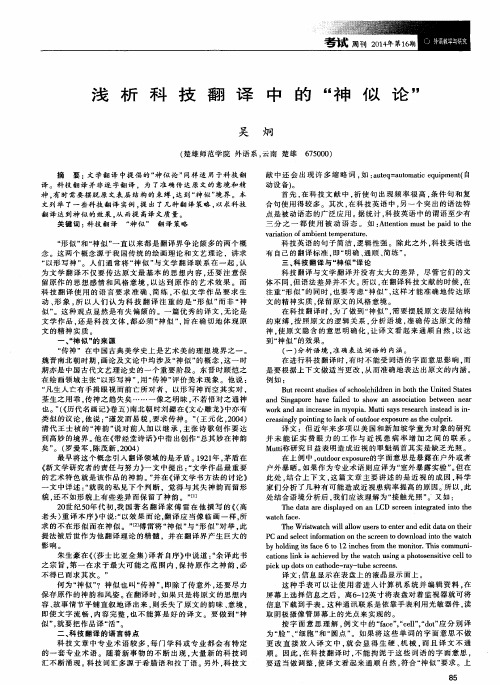
、
பைடு நூலகம்
荃生之用乖 , 传 神之 趋 失 矣 … … 一 像 之 明昧 , 不 若 悟 对 之 通 神 也 。” ( 《 历代名画记》 卷五 ) 南北 朝 时刘 勰 在《 文心雕龙》 中亦 有 类似的议论 , 他说 : “ 谨发 而易貌 , 要求传 神。” ( 王元化 , 2 0 0 4 ) 清代王士祯 的“ 神韵” 说 对前人加 以继承 . 主 张 诗 歌 创 作 要 达 到高妙的境界。 他在《 带经 堂诗 话 》 中指出创作“ 总 其 妙 在 神 韵 矣” 。( 罗爱军 , 陈茂 新 , 2 0 0 4 ) 最 早 将 这 个 概 念 引 入 翻译 领 域 的 是矛 盾 。 1 9 2 1 年, 茅 盾 在 《 新 文 学 研 究 者 的责 任 与 努力 》 一 文 中提 出 : “ 文 学 作 品 最 重 要 的艺术特色就是该作品的神韵。 ” 并在《 译文学书方法的讨论》 文中详述 : “ 就 我 的 私 见 下 个 判 断 ,觉 得 与 其 失 神 韵 而 留形 貌, 还 不 如 形 貌 上 有 些 差 异 而 保 留 了神 韵 。” … 2 0 世纪5 0 年代 初, 我 国 著 名 翻译 家 傅 雷 在 他 撰 写 的 《 ( 高 老头 ) 重译 本序》 中说 : “ 以效果 而论, 翻译应 当像临 画一样, 所 求的不在形似而在神似 。” 傅 雷 将 “ 神似 ” 与“ 形似 ” 对举 , 此
三 分 之一 都使 用 被动 语 态 。如 : A t t e n t i o n mu s t b e p a i d t o t h e
目的论视角下科技类文本的翻译

目的论视角下科技类文本的翻译随着全球化的深入和科技的飞速发展,科技类文本的翻译变得越来越重要。
科技类文本包括各种与技术、工程、计算机等领域相关的文献,如科学论文、技术手册、专利申请等。
这些文本的翻译不仅需要准确传达原文的含义,还需满足特定目的和受众的需求。
本文将从目的论视角探讨科技类文本的翻译。
目的论是翻译理论的一个重要分支,由德国学者汉斯·弗米尔于1978年提出。
目的论认为,翻译过程中译者的首要任务是确定翻译的目的,并根据目的选择合适的翻译策略。
在科技类文本的翻译中,目的通常是为了传达特定信息、解决问题或促进技术交流。
科技类文本的翻译具有特殊性。
这类文本往往包含大量的专业术语和复杂的句子结构,这增加了翻译的难度。
科技类文本的读者往往具有特定的背景和需求,因此翻译不仅要考虑语义的准确性,还需读者的认知背景和交际需求。
在目的论视角下,科技类文本的翻译可采取以下策略:充分理解原文:对于科技类文本,理解原文的含义是翻译的关键。
译者需要熟悉相关的专业知识和背景,以准确传达原文的含义。
考虑读者需求:在确定翻译目的时,译者需要考虑读者的背景和需求。
例如,如果翻译的目的是为了指导读者解决技术问题,那么译者在翻译过程中应如何使译文更清晰、更易于理解。
适当调整语言风格:科技类文本往往使用复杂的语言和表述方式,这可能影响读者的理解。
译者在翻译过程中应根据目的和读者的需求,适当调整语言风格,使译文更加通俗易懂。
保持信息的准确性:科技类文本中往往包含关键的信息和技术细节,这些信息在翻译过程中必须准确传达。
译者应采取措施确保翻译的一致性和准确性,避免因翻译错误导致的技术问题。
参考权威资料:在翻译科技类文本时,译者可以参考权威的资料和规范,以确保翻译的准确性和专业性。
例如,在翻译专业术语时,可以查阅行业标准、学术论文等资料,以确保翻译的准确性。
目的论为科技类文本的翻译提供了有力的理论指导。
在翻译过程中,译者应根据具体的目的和读者的需求,采取合适的翻译策略,以确保准确传达信息并满足读者的需求。
试论科技口译的译前准备
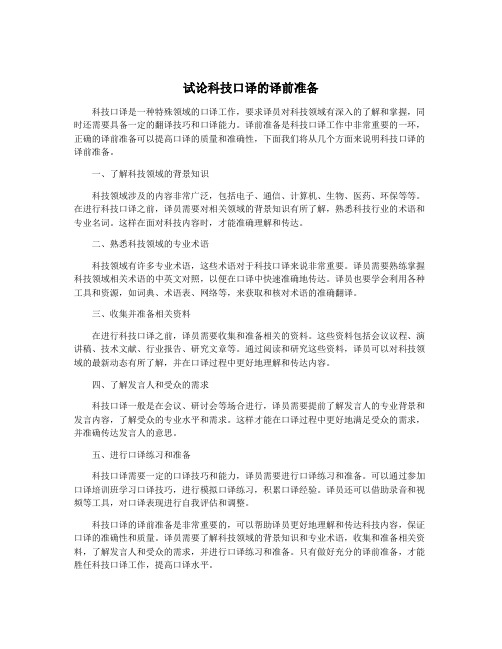
试论科技口译的译前准备科技口译是一种特殊领域的口译工作,要求译员对科技领域有深入的了解和掌握,同时还需要具备一定的翻译技巧和口译能力。
译前准备是科技口译工作中非常重要的一环,正确的译前准备可以提高口译的质量和准确性,下面我们将从几个方面来说明科技口译的译前准备。
一、了解科技领域的背景知识科技领域涉及的内容非常广泛,包括电子、通信、计算机、生物、医药、环保等等。
在进行科技口译之前,译员需要对相关领域的背景知识有所了解,熟悉科技行业的术语和专业名词。
这样在面对科技内容时,才能准确理解和传达。
二、熟悉科技领域的专业术语科技领域有许多专业术语,这些术语对于科技口译来说非常重要。
译员需要熟练掌握科技领域相关术语的中英文对照,以便在口译中快速准确地传达。
译员也要学会利用各种工具和资源,如词典、术语表、网络等,来获取和核对术语的准确翻译。
三、收集并准备相关资料在进行科技口译之前,译员需要收集和准备相关的资料。
这些资料包括会议议程、演讲稿、技术文献、行业报告、研究文章等。
通过阅读和研究这些资料,译员可以对科技领域的最新动态有所了解,并在口译过程中更好地理解和传达内容。
四、了解发言人和受众的需求科技口译一般是在会议、研讨会等场合进行,译员需要提前了解发言人的专业背景和发言内容,了解受众的专业水平和需求。
这样才能在口译过程中更好地满足受众的需求,并准确传达发言人的意思。
五、进行口译练习和准备科技口译需要一定的口译技巧和能力,译员需要进行口译练习和准备。
可以通过参加口译培训班学习口译技巧,进行模拟口译练习,积累口译经验。
译员还可以借助录音和视频等工具,对口译表现进行自我评估和调整。
科技口译的译前准备是非常重要的,可以帮助译员更好地理解和传达科技内容,保证口译的准确性和质量。
译员需要了解科技领域的背景知识和专业术语,收集和准备相关资料,了解发言人和受众的需求,并进行口译练习和准备。
只有做好充分的译前准备,才能胜任科技口译工作,提高口译水平。
从纽马克文本功能理论看科技英语文本翻译策略

现代经济信息从纽马克文本功能理论看科技英语文本翻译策略丁 杰 孙勇强 黑龙江科技大学外国语学院摘要:纽马克文本功能理论是当今翻译界重要的功能翻译理论之一。
科技英语翻译属于应用翻译范畴,根据纽马克文本功能理论,大部分科技文本以传递信息为主是典型的“信息型”文本,但随着科技的发展、科技文本读者群体扩大,一些科技文本也具有呼唤功能。
本文将以纽马克的文本类型理论为依据,结合所选取的科技文本的语言特点,探讨此类具有信息型文本功能及呼唤功能的科技文本的翻译策略。
关键词:纽马克文本功能理论 ;科技英语;信息型文本;呼唤功能中图分类号:H059 文献识别码:A 文章编号:1001-828X(2016)033-000362-02一、体裁和文本Genre(体裁)一词源于法语,起先主要是指文学领域的文学类型。
genre是“随着时代改变而不同的一组构成性约定和规范,是作者和读者之间形成的未明示的合约。
这些规范使得某一文学文本的创作成为可能,尽管作者遵循也可以违背通行的文类约定”[1]。
随着研究的深入和扩大,体裁发展到用于语言学和翻译学界。
语言学中,指按照约定俗成的形式表达的文本。
体裁对于翻译来说是重要概念,翻译过程中,译者必须分析源语文本的文类属性,并用目标语中相应的文类进行转换。
genre最重要的特点就是其语篇的规约性。
德国翻译学者在论述文本类型的时候,很少使用genre这一术语,而是使用text一词,认为text的内涵和外延要广一些,text汉语中有“篇章”、“文本”、“语篇”、“话语”等不同译名。
二、纽马克的文本功能理论英国翻译理论家纽马克将语言功能和翻译结合起来, 文本功能理论中,文本类型为text category。
根据 Karl Bühler的语言功能学说,在莱斯的“信息型”、“表达型”和“祈使型”三类文本类型基础之上,将各类文本体裁划分为 “表达型文本”(expressive text)、“信息型文本”( informative text) 和 “呼唤型文本” (vocative text)三大类, 并分别指明了各自的文本“核心”和作者在翻译中的“身份”:功能(Function)核心(Core)作者身份(Author'sstatus)文本类型(Type)表达型(Expressive)作者(Writer)神圣(Sacred)严肃文学作品(Serious imaginativeLiterature),官方文告(Authoritativestatements),自传(Autobiography),私人书信(Personal Correspondence)信息型(Informative)事实(Truth)匿名(Anonymous)主题(Topic)文本(Format)科学(Scientific)技术(Technological)商务(Commercial)工业(Industrial)经济(Economic)教材(Text book)报告(Report)论文(paper)文件(Article)备忘录(Memo)纪要(Minutes)呼唤型(Vocative)读者层(Reader-ship)匿名(Anonymous)告示(Notice),说明书(Instruction),宣传(Propaganda),广告(Publicity),通俗小说(Popular fiction)(Newmark:2001:40)针对三种不同功能的文本,纽马克提出了语义翻译(semantic translation)和交际翻译(communicative translation)这两种翻译方法,用于他的文本分类体系中。
目的论视角下科技新闻翻译策略
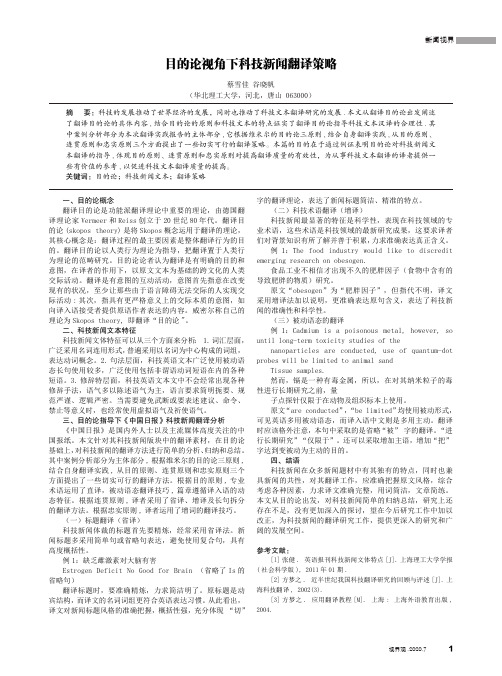
新闻视界1视界观.2020.7目的论视角下科技新闻翻译策略蔡雪佳 谷晓帆(华北理工大学,河北,唐山 063000)摘 要:科技的发展推动了世界经济的发展,同时也推动了科技文本翻译研究的发展.本文从翻译目的论出发阐述了翻译目的论的具体内容,结合目的论的原则和科技文本的特点证实了翻译目的论指导科技文本汉译的合理性.其中案例分析部分为本次翻译实践报告的主体部分,它根据维米尔的目的论三原则,结合自身翻译实践,从目的原则、连贯原则和忠实原则三个方面提出了一些切实可行的翻译策略。
本篇的目的在于通过例证表明目的论对科技新闻文本翻译的指导,体现目的原则、连贯原则和忠实原则对提高翻译质量的有效性,为从事科技文本翻译的译者提供一些有价值的参考,以促进科技文本翻译质量的提高。
关键词:目的论;科技新闻文本;翻译策略一、目的论概念翻译目的论是功能派翻译理论中重要的理论,由德国翻译理论家Vermeer 和Reiss 创立于20世纪80年代。
翻译目的论(skopos theory)是将Skopos 概念运用于翻译的理论,其核心概念是:翻译过程的最主要因素是整体翻译行为的目的。
翻译目的论以人类行为理论为指导,把翻译置于人类行为理论的范畴研究。
目的论论者认为翻译是有明确的目的和意图,在译者的作用下,以原文文本为基础的跨文化的人类交际活动。
翻译是有意图的互动活动,意图首先指意在改变现有的状况,至少让那些由于语言障碍无法交际的人实现交际活动:其次,指具有更严格意义上的交际本质的意图,如向译入语接受者提供原语作者表达的内容。
威密尔称自己的理论为Skopos theory, 即翻译“目的论"。
二、科技新闻文本特征科技新闻文体特征可以从三个方面来分析: 1.词汇层面,广泛采用名词连用形式,普遍采用以名词为中心构成的词组,表达动词概念。
2.句法层面,科技英语文本广泛使用被动语态长句使用较多,广泛使用包括非谓语动词短语在内的各种短语。
论科技英语翻译中的美学标准
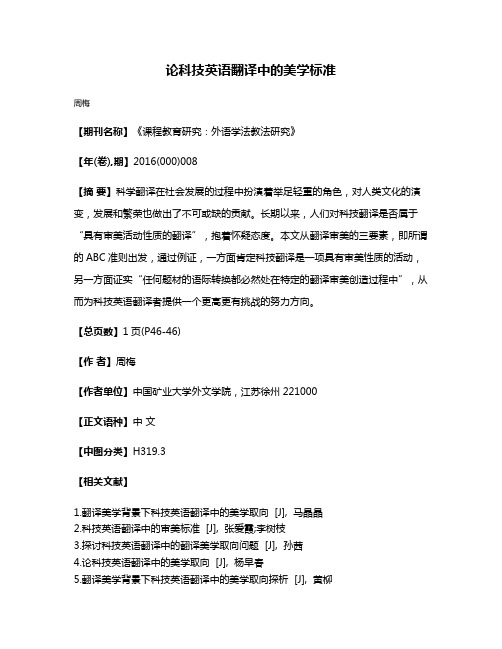
论科技英语翻译中的美学标准
周梅
【期刊名称】《课程教育研究:外语学法教法研究》
【年(卷),期】2016(000)008
【摘要】科学翻译在社会发展的过程中扮演着举足轻重的角色,对人类文化的演变,发展和繁荣也做出了不可或缺的贡献。
长期以来,人们对科技翻译是否属于“具有审美活动性质的翻译”,抱着怀疑态度。
本文从翻译审美的三要素,即所谓的ABC准则出发,通过例证,一方面肯定科技翻译是一项具有审美性质的活动,另一方面证实“任何题材的语际转换都必然处在特定的翻译审美创造过程中”,从而为科技英语翻译者提供一个更高更有挑战的努力方向。
【总页数】1页(P46-46)
【作者】周梅
【作者单位】中国矿业大学外文学院,江苏徐州221000
【正文语种】中文
【中图分类】H319.3
【相关文献】
1.翻译美学背景下科技英语翻译中的美学取向 [J], 马晶晶
2.科技英语翻译中的审美标准 [J], 张爱霞;李树枝
3.探讨科技英语翻译中的翻译美学取向问题 [J], 孙茜
4.论科技英语翻译中的美学取向 [J], 杨早春
5.翻译美学背景下科技英语翻译中的美学取向探析 [J], 黄柳
因版权原因,仅展示原文概要,查看原文内容请购买。
- 1、下载文档前请自行甄别文档内容的完整性,平台不提供额外的编辑、内容补充、找答案等附加服务。
- 2、"仅部分预览"的文档,不可在线预览部分如存在完整性等问题,可反馈申请退款(可完整预览的文档不适用该条件!)。
- 3、如文档侵犯您的权益,请联系客服反馈,我们会尽快为您处理(人工客服工作时间:9:00-18:30)。
On How to be a Good Sci-Tech Translator 论如何当好科技翻译ContentsContents (1)Abstract (2)Acknowledgements (3)1.Introduction (4)2.Full realization of opportunities and challenges confronting sci-tech translators (4)3.Being aware of sci-tech translators’ importance (4)4.Requirements for a good sci-tech translator (5)4.1 Good comprehensive abilities (5)4.2 Acquaintance of professional knowledge concerned (7)4.3 Rich translating experience (7)5. Conclusion (8)Bibliography (9)AbstractDirected at the status quo shown in the working situation of sci-tech translators, this paper first analyses the opportunities and challenges facing them since China’s entry into the World Trade Organization and then presents sci-tech translators’role and, with reference to the author’s experience, discusses the requirements for a good sci-tech translator, namely he or she shall have good comprehensive abilities : a good command of both TL and SL, highly adaptable to various occassions like a brainman and strong commuication skills ; professional knowledge ; rich translation experience, etc.Key Words: Sci-tech translator, role, requirements, brainman, professional knowledge摘要针对许多科技翻译人员在工作实践中反映出的现状,本文分析了入世后科技翻译所面临的机遇和挑战,阐述了科技翻译的作用,并结合笔者的一些亲身经历,讨论了当好科技翻译的要求: 科技翻译人员应具备较高的综合素质,不但要有过硬的双语能力,而且要有参谋般的应变能力和较强的交际能力, 更要学习专业知识,才能更好的理解原文;科技翻译工作者还须有丰富的实践经验。
关键词:科技翻译,作用,要求,参谋,专业知识AcknowledgementsI want to express my appreciation to many people, who supported my efforts in writing this paper during the past few months.I am greatly indebted to library assistants, who supplied me with a lot of useful reference materials.Hearty thanks should also be given to my colleague, who gave me quite a few good suggestions.Special thanks should be extended to my tutor Huangwen, who kindly helped me eliminate many of the errors in this paper and gave me good instructions.Without their support and assistance, this paper would not have been possible.1.IntroductionIn the 21st century, the knowledge-based economy will gradually dominate the international community. Modern science and technology are experiencing explosive development and frequent cooperation between countries are taking place here and there. The successful entry of China into the World Trade Organization in the year of 2001 heralds the china’s subsequent active participation in globalization in a greater and deeper degree and also means its further exchanges with other countries in technology, economy and foreign trade.The rapid economic development and fast progress of our society have already brought unprecedented opportunities and challenges to sci-tech translators. Facing with the new trend, it has been realized that the status quo of these translators remains far from satisfactory. Most of them have problems such and such while doing the practical work. Some are short of professional knowledge and others have no good idea about the consequence of their poor quality or even wrong translation. Therefore, this paper combing with the author’s personal experience, aims to share some immature thoughts on the requirements for a good sci-tech translator. It is hoped that this paper could make a contribution to the improvement of sci-tech translators’ qualities.This paper will include four parts: opportunities and challenges confronting sci-tech translators, full realization of sci-tech translators’importance, requirements for a good sci-tech translator and conclusion.2.Full of realization of opportunities and challenges confronting sci-tech translatorsSince Chin a’s entry into the World Trade Organization, the most obvious opportunity for sci- tech translators is that the extent of foreign exchanges has been expanded greatly, which has resulted in great potential for the development of translation-related market and a great demand of translators. As it is know to us all, many Western financial institutions and big enterprises are flocking into China to make investments in Chinese capital market and to establish joint ventures and also some of them to run schools. At the same time, Chinese enterprises are starting practising the strategy of “going out” to learn advanced technology, good managerial skills and admonitory experience from abroad. Absolutely, all of this requires a great amount of high quality sci-tech translators and thus creates opportunities for them.Meanwhile sci-tech translators have to be aware of the challenges. On the one hand, nowadays the law of “survival of the fittest” has been replaced by “survival of the fastest” and the globalization process is sped up. To be laid back only leaves to be attacked. On the other hand, foreign technical exchanges and other economic or commercial activities involve diverse disciplines, multiple fields, large translation task and various languages. Taking a large project like the Dayawan Nuclear Power Plant for instance, it concerned itself with the translations in the fields of mechanics, electronics, computer science, control automation and nuclear physics, etc, the translation quantity up to 160,000,000 words in English, French and other lauguages. Therefore the trend has prompted a headache to the sci-tech translators, that is, how to do the translation work in most high efficiency and in highest possible quality so that we can keep up with world’s steps.3. Being aware of sci-tech translators’ importanceTranslation as a kind of cultural phenomenon and means of cultural exchange has existed long time ago. “Translated works serve a useful purpose for a vast reading public who seek knowledgeworld-wide but lack the ability to read books in the original language. An indispensable medium, sci-tech translation has helped promote academic and technical exchange.” (Mengzhi Fang, 1993) The Four Great Inventions of China-paper, printing, the compass and gunpowder-greatly advanced civilization worldwide. Likewise, the achievements of modern science in the West have changed the life of the Chinese people. In a rapidly developing society today, language shall be also a basic tool for promoting the economic development and our society’s whole progress instead of being just a tool for idea exchanges. A modernized society engages its work in a well-organized way instead of in a disorderly way. Each organization or cell in the society shall carry out their jobs in a dividing way and at the same time mutually cooperate with each other so as to give full play to the role of a society as a whole. Translation, as a means for mutually understanding between people using different languages, has been receiving more and more attention, which is a key to international understanding. In future, it may be very likely that an ethnic group could disappear due to a delayed translation of one or few words. That is why some people say “no translation means death”. The seriousness of this point is usually neglected till some fatal accidents or even war happens because of the failure in instantaneous information transmission. For example, in 1970, several Americans ate a kind of poisonous mushrooms and American doctors had no idea about the cure and hence caused deaths within a few days. Later on, a pharmaceutist learned of this news through radio and he knew one treatment was once successfully applied in 1959 and had been published broad. Then why the American doctors did not know the treatment seven years later? The reason is that the relevant report published was not translated into English. One more recent example, the terrorists’attack of 9.11 directly led America to fight against the terrorist organization in Afghan and its influence to the political situation of Western Asia and also the society, economy and politics of America is unprecedented. But it is reported that CIA once intercepted an episode of several terrorists’ conversation on Sept. 10th indicating that something terrible would take place next day and unfortunately this conversation in Arabian was translated till Sept. 12nd. Presumably, what if this information was translated on Sept. 10th? V ery probably, the whole situation could be changed. After its entry into WTO, China needs to introduce advanced political, cultural, scientific and technological and economic information and meanwhile shows its historical, cultural, political and economic information in front of the world. In this case, sci-tech translators become indispensable as a mutual communication bridge. They are necessitated to take part in the translation of feasibility seminar, business negotiation, international academic conference, scientific report and exhibition and so on. All in all, timely and accurate translation could play a big role in the development of a nation’s economic, political and military and other fields.4. Requirements for a good sci-tech translator4.1 Good comprehensive abilitiesSci-tech translation, being an important branch of translation, is a kind of language activity in which people using different languages conduct information exchanges in science and technology field, which entails the accurate expression of scientific concept and the precise reflection of the characteristics of things described. The nature of sci-tech translation has determined that the translation must be precise and constricted to the original meaning. Information loss or random translation is strictly forbidden. Clearly, invariable translation will not produce desirable effects as any two languages are almost totally different in their styles and rules. Therefore, suitableadjustment is essential on the basis that the original meaning is not damaged. For instance, this sentence “two widely used alloys of copper are brass and bronze” shall be translated inversely as “brass and bronze are two widely used alloys of copper”. Any negligence in translation can result in the loss of scientific information or affect the translating quality. In view of this, a sci-tech translator shall not only have a good command of SL and TL, he or she shall also have acquaintance of relevant professional knowledge and cultivate rigorous thinking mode and the ability to skillfully exercise certain translating techniques. Along with the rapid development of modern telecommunication technology, the information highway has already greatly shortened the person to person distance and has made the Earth a global village. Thanks to the advanced technology, sci-tech translators can gather a great amount of information required by referring to Internet browser.Sci-tech translation could be related to all kinds of fields like natural science, social science, artistry, etc. and is involved in the whole process of foreign affairs such as foreigners’ reception, hotel service, project cooperation, traveling, scientific and cultural exchanges and so on. In the foreign exchanges, a sci-tech translator is not only just a language transformer, but also a spokesman. Objectively, he or she is on behalf of the interest and image of their company and country. Hence sci-tech translators must pay attention to the improvement of their qualities in terms of morals, knowledge, communication skills or in their character, personality or deportment, trying to excel in using SL and TL to accomplish exact, clear and fluent translation. Sci-tech translators’ bridge role is self-evident. Especially in business negotiations, such a role has become the gauge of translators’comprehensive abilities. How the translation is performed can directly influence the atmosphere and even the success of negotiation. The bridge role is not simply transformation of words, but also includes the communication of emotions. In most negotiations, translators can ameliorate the discussion atmosphere by choosing proper expression, appropriate tone, sincere attitude, reasonable persuasion and generous behavior, etc.. Apparently, the translators are just language transformers, but deep down they are assisting the negotiations of their side to achieve expected results, playing the role of a brainman. Such an ability becomes more noticeable on occasions of foreign reception, cultural exchanges, top-level meetings, grand ceremonies and such. Humorous and elegant language, wide knowledge, hospitable personality and decent manners can present great charm and form an invisible ribbon drawing close two negotiating parties and engendering willingness for mutual cooperation, which could produce an intangible effect enhancing mutual parties’trust and solving unnecessary contradictions and finally leading negotiation to success. Take one of the author’s personal experiences for example, one Jordanian customer wanted to buy a large equipment and he insisted on adopting all electrical components from famous European companies. However the manager of the equipment supplier the author represented refused this and said it was impossible to satisfy that requirement. This made the negotiation come to a halt. Both parties showed unwillingness to make any concessions on the matter. And it seemed this big contract would come down the drain because of such a trivial matter. If so, what a pity it would be! At this moment, the author, with a flickering of wit, gave the following remarks: “ How about this way: the supplier shall try its best to buy the components from Europe. If not successful, it shall ask its client for help.” and thus broke the deadlock. Good comprehensive abilities of translators can be one kind of invisible capital, to be determined by comprehensive qualities and be obtained only by frequent practice.4.2 Acquaintance of professional knowledge concernedTranslation is a process of language conversion and the first step is to understand the meaning of SL. For ordinary readings, it just takes common knowledge to understand. While for professional articles or speech in technical exchanges, common readers, no matter how good they are at source language, could hardly understand the content if without knowing certain relevant specialty knowledge. As the old Chinese saying goes, difference in profession makes one feel worlds apart. An outstanding translator always feels difficulties and makes mistakes when working at a strange specialty or in a new filed. Some mistakes can even rock people in the aisle. In 1930s, there was once a famous literator, who translated “the Milky Way” into “the way made of milk” and thus attracted a lot of mocks from the public. Actually “the Milky Way” is a terms in astronomical field, which shall be construed as galaxy. Reading professional articles or engaging in technical exchanges are always those technicians with rich professional knowledge. Each terms in the articles or in the speech of technical exchanges has its own particular meaning. Those terms are used between technicians as jargons taking on specialty features not contained in literary or artistic language. Therefore, as a sci-tech translator, he or she must use precise, proper, basically equivalent words (technical terms) and appropriate expressional forms depending on the specialty to complete information’s conversion, making the translation version play the same role as the original version or rendering the objective facts in the translated article or speech in conformity with the original ones. To achieve that, sci-tech translators have to acquaint themselves with relevant professional knowledge. Otherwise they will have difficulties in understanding the original version, let alone correct and fluent translation. Take a look at this example: the gear is, by a key, attached to the shaft put on two bearings driven by an electromotor. If without certain knowledge of mechanics, the translator would have no idea about the meaning of the sentence, especially the meaning of key words like gear, key, shaft and bearing. In this case, he or she could not find equivalent words in target language and hence could not translate the sentence with proper technical terms and good logic.Sci-tech translation and professional knowledge are closely associated and shall not be separated. The process of translation is more a process of logical analysis rather than a simple language transformation activity. The author has several colleagues being technicians. Though their English standards are not so high as those college graduates majoring in English, they can always translate the technical articles or interpret the conversation in technical exchanges more precisely and completely and so avoid the situation of repetitive confirmation due to bad communication and make sure that the conference could be performed in a coherent, fluent and productive way. They can do this because they have profound professional knowledge and can easily follow the speaker’s logic instead of giving all ears to the language in itself. Perhaps, they are not very fluent while doing the translation, but they always can precisely express technical terms and accurate logic relationship, which can compensate their language incompetence and result in productive effects. The author even comes across some technicians who do not know English at all, yet they sometimes can basically understand the speech of a foreign technician by observing his gestures or facial expressions. The above two cases show that sound professional knowledge can help the sci-tech translators greatly in the accurate understanding of source language and high quality translation.4.3 Rich translation experienceTranslation is a sort of highly practical work, so practice is essential for a good translator. Agood translator shall take each translation activity as a good opportunity for learning, practicing and making progress, always remember to sum up and turn over to think about the weak points in the translation process and try to do better next time. However, Rome is not built in one day. Translation level improves as practice increases. Generally, written translation shall be first done more than oral interpretation as it does good for improving the ability of sentence construction, analysis and inference and hence benefits oral interpretation. There are always a lot of translation techniques like increasing and decreasing words, converting word classes, dealing with word order applied in written translation so as to get rid of the ties of original version’s form. To use those techniques skillfully, a great amount of practice is absolutely indispensable. Oral interpretation is a higher-level translation work best reflecting a translator’s comprehensive abilities. Different from written translation, the interpreters have to rapidly discriminate, judge, summarize and accurately express the meaning of speakers though some speakers are speaking with strong accent or even neglect to spare time for interpreters to record and organize expressions. Besides, interpretation is a real-time and interactive process and it can bring great psychological pressure. Such pressure can make interpreters feel timid as they are afraid of mistranslating or missing any word. The author’s first interpretation in a formal technical meeting is still fresh in the mind really having the heart in the mouth. However, these difficulties must be faced up to. To overcome them, the interpreters have to practise more in order to build up the confidence, to overcome psychological barriers, to walk out of the nervous and worrying state and finally to experience the happiness and pleasure of success.5. ConclusionAlong with the rapid development of science and technology, many new disciplines and fields have come into existence one after another, which has brought numerous scientific terms and also great difficulties for sci-tech translations. Confronted with such a situation, sci-tech translators have to keep learning, broaden their knowledge, skillfully master translation techniques, enhance their comprehensive abilities and acquire a solid grasp of SL and TL and rich professional knowledge concerned. Only in this way, the quality of translation could be guaranteed.Above all, sci-tech translators standing in the front of advanced science and technology shall take advantage of all kinds of modern facilities to improve their working efficiency, precisely and rapidly acquire scientific information, ensure information exchanges in an unobstructed way and enhance the development of our society’s economy, science and technology, playing well the role of international cooperation’s bridge and making our country’s development to keep pace with the world’s trend.To be a good sci-tech translator, he or she must be fully aware of their challenges and roles, seize tightly good opportunities, try to achieve the requirements necessitated and love their work and give full play to their bridge role in the globalization process.BibliographyFang, Mengzhi, 1993. Selected Readings Translation Theories. Shanghai Far East Press. 黄荣恩,1981, 《科技英语翻译浅说》北京:中国对外翻译出版公司。
